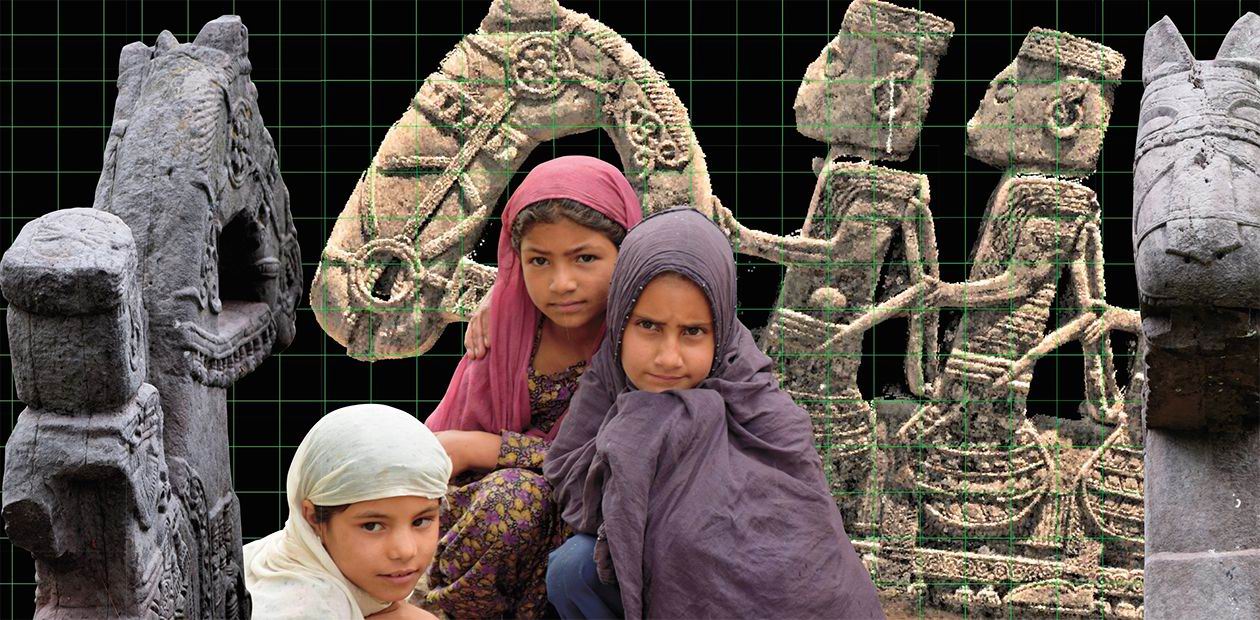Riders lost in the Himalayas
The Pir Panjal is a mountain range situated in the western part of the Lesser Himalayas extending from the east-southeast to west-northwest across the border of Himachal Pradesh and Jammu and Kashmir. The sights are awesome: lofty peaks rising to the heights of up to 4,000 meters above the sea level, swift-flowing streams and deep-set valleys overgrown with cedars and scattered tiny houses surrounded by little fields.
In June 2017, this was the site of a Russian-Indian archaeological expedition launched to find and describe stone horses, enigmatic statues lost in remote mountain areas
“Animals don’t asleep. In the dark after nightfall
They stand over the world like a stone wall…”
The Horse’s Face by N. Zabolotsky
This story began in 2013, when at the entrance to the Archaeology Museum of Srinagar, the administrative center of the Indian state of Jammu and Kashmir, I saw two stone horses with riders. They did not look like anything I had ever seen throughout my career in archaeology. My questions about the origin and owner of these statues took me nowhere, nor did I find any mention of them in scholarly literature. Oddly, the horses were enshrouded in silence and oblivion, which was out of all proportion to what they were. There appeared to be no place for them in the Indian History of Art.
Ever since I had longed to see the locality where these captivating statues came from. It was only in 2017 that my desire became a reality thanks to the financial support of the Gerda Henkel Foundation. An expedition launched to the village of Gool, District Ramban, Jammu Region, Jammu and Kashmir State, India, included, from the Indian side, Dr. Mohammad Ajmal Shah, Assistant Professor-cum-Curator, and Yatoo Mumtaz Ahmad, Assistant Professor (Archaeology), affiliated with the Centre of Central Asian Studies at the University of Kashmir, India.
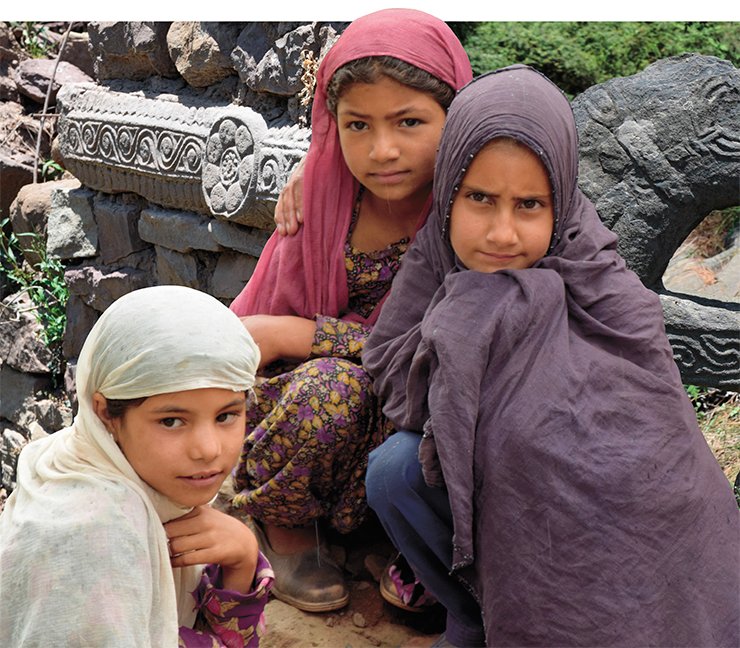
People living in this area have known all along that the Pir Pajal is home to amazing countless (because nobody has ever counted them) horse statues with riders – undated and found in most unlikely places. One such site near the village of Gool was turned into a sort of open-air museum: some of the statues and slabs that you can see there were brought from the adjacent fields, where they got in the way of planting. Many statues have been broken; their fragments make part of alleys and walling around fields and houses; slabs with depictions were used to make benches. Locals call this site, which is two kilometers from the village of Gool, Ghoragali, which means “Horses pass.” You can also see statues in streams, where they are used for washing clothes. The local residents do not know anything about their origin: for most of them, the statues are alien and strange. Those who are remotely interested in them consider them to be traffic signs for the caravans that roamed the region in the time of Mahabharata. This, however, is way off the mark.
Strikingly, these outstanding monuments of an unknown culture have not been studied though the locality is on the list of the cultural heritage sites protected by the state. One reason is that the monuments are hard to access; another reason is that they are so original that cannot be unambiguously attributed as belonging to any of the modern cultures or religions. To record and describe the monuments, 3D surface laser scanning was performed by a team from Trimetary Consulting (St Petersburg) led by Mikhail Anikushkin. As of today, this is the most precise technology for recording numerous objects.
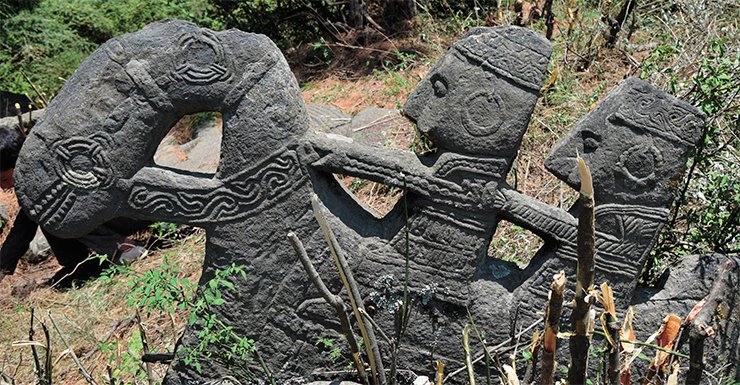
The work was done in two clusters, where the numerous stone sculptures are concentrated, located the height of 1,890 meters and 2,030 meters above the sea level. The area of each cluster is about a hectare. In addition to laser scanning, airborne survey using a quadcopter and survey photography using a digital single-lens reflex camera were performed.
The laser scanning yielded a point cloud containing exhaustive information concerning the geometry of the objects, their spacing and micro-relief of the locality. The data obtained can be used for scientific studies, excavation planning, and visualization of the survey objects. On top of that, they contribute to the conservation of an endangered cultural heritage site, which is under the threat of both human intervention and natural hazards, quite frequent in this region.
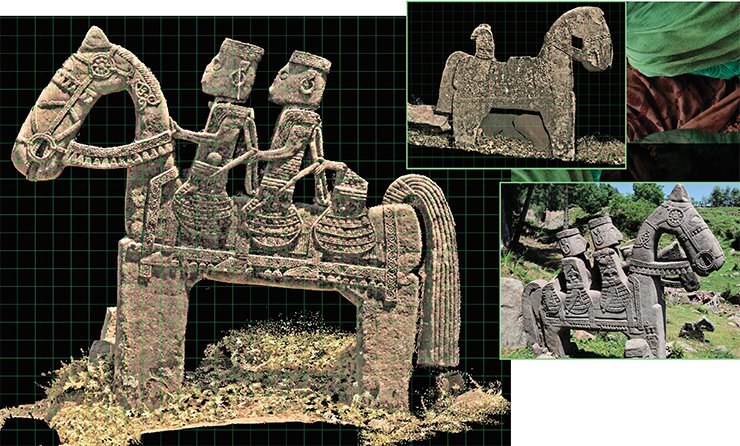
In the future, we are planning to create, on the basis the point cloud, a real-world 3D model of the objects and an interactive 3D application. The application can be developed into a virtual reconstruction in several versions, that is, actually, into a virtual museum accessible to the scientific community and broad public.
Hephthalite trace?
Undoubtedly, the monuments date from the pre-Muslim period of the region’s history though they are neither Buddhist nor Hindu. We are facing an entirely original cultural layer supposedly belonging to a “dark” period of Indian history connected with the Hephthalite conquest and rule (5th to 7th cc.). This ethnicity was as enigmatic as it was powerful and left a detectable trace in the history of both Central Asia and India.
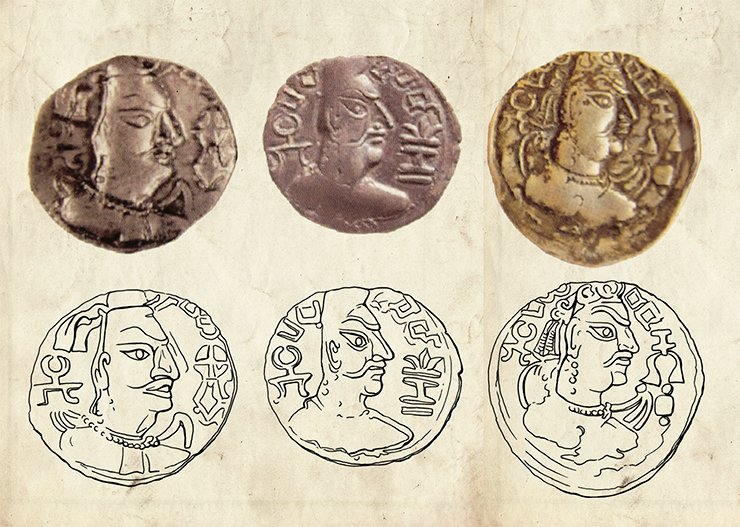
The origin of the Hephthalites is still a subject of scholarly dispute. Opinion is divided: some believe them to be descendants of the Yuezhi, who spoke Iranian languages, while others argue that they came from the ancient Mongols or Huns, who had assimilated Central-Asian ethnic groups. On top of that, there is a wide variety of hypotheses suggesting that the Hephthalites originate from the Altai Mountains, Northern China, Badakhshan, Aral Sea Region, the Syrdarya, and so on. Summarizing this issue, A. D. Kurbanov writes in his survey of the Hephthalite history that “the Hephthalite period remains to be one of most mysterious in the history of Central Asia. The archaeological data are scarce and information found in narrative sources is intricate, which is a great challenge for the researchers. Only future archaeological findings may help to solve a number of controversial issues of the Hephthalite ethnogenesis” (Kurbanov, 2006).
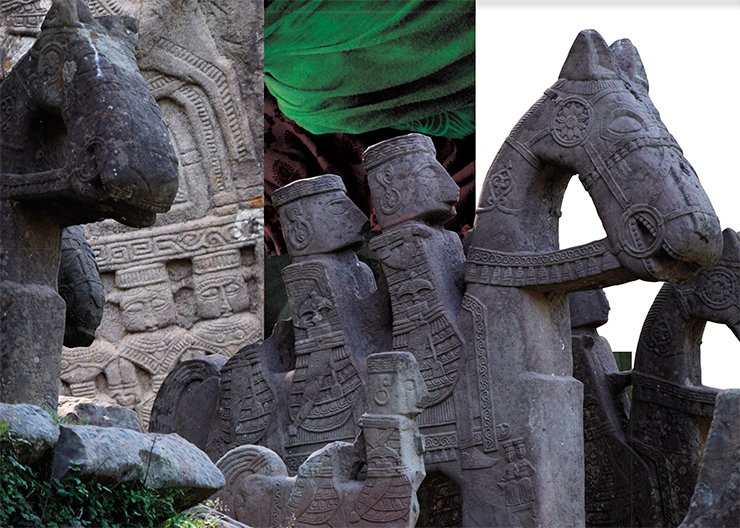
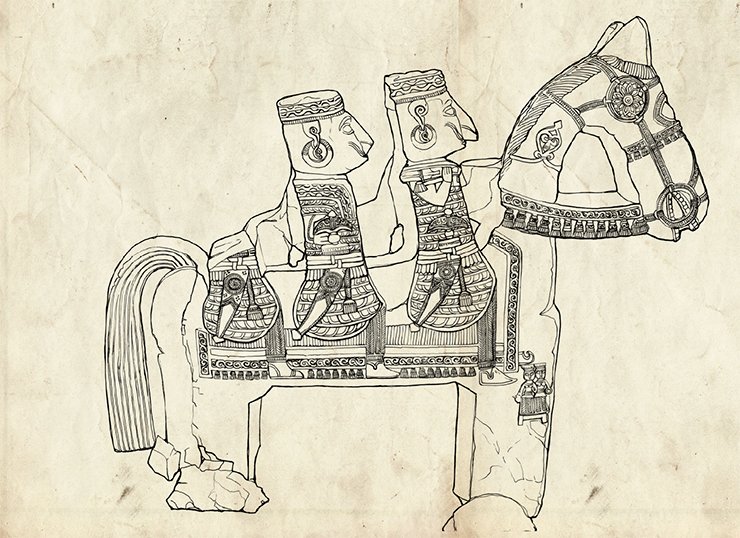
Toramana ruled until 515, and under his power, the indianization of the White Huns (Sveta Huna) was taking place. Toramana’s son Mihirakula (the Huna name is Mihirakugula) succeeded his father on the throne and adopted Shaivism, one of the major traditions within Hinduism that worships Shiva. He is reputed to be a cruel ruler, who prosecuted the Buddhists and destroyed quite a number of temples (the latter though is currently questioned). Having lost a few battles to tribal leaders, he returned to Kashmir, where he ruled until 537 and died. His descendants continued to rule Kashmir and the greater part of Punjab for another 150 years.
The last Hephthalite ruler of Kashmir was Toramana’s offspring, Lakharna, who governed until 670. Many scientists agree that the Hephthalites contributed a lot to the making of the ethnicities populating the mountain areas of Northwestern India
Indeed, when the potential of analyzing the written sources is exhausted and the matter is not clear, we can only rely on archaeological exploration that may give fresh impetus to an old problem.
There is a hypothesis that the last part of the name of the Hephthalite ruler Mihirakula, “gula,” meant a certain rank of a “ruler-warrior.” This word must have given name to the Gulot dynasty, whose representatives currently govern Udaipur, the capital of the large province of Mewar, Rajasthan (Uspenskaya, 2000). The settlement located near the site where the horse statues are found is called Gool, which might derive from the name of the Hephthalite tsar-warrior.
Stone army
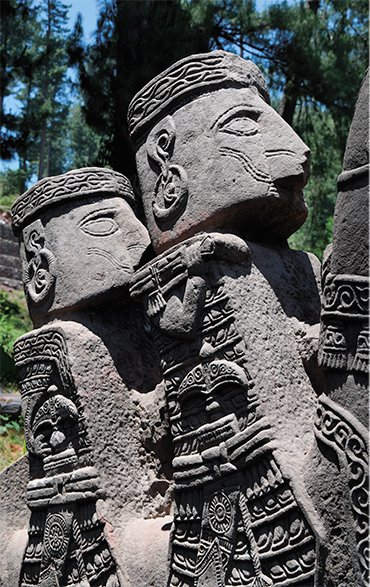 Horse soldiers would always approach India from the north-west, as did all the conquerors including Alexander the Great. In India, they could not breed horses, so there was no native equestrian culture. It was imported by nomads-conquerors, who would establish their own states within the Indian Territory. In different historical periods, India was attacked by Aryans, Saka, Kushans, Hephthalites, Turks, Mongols… There is, hence, a high probability that so numerous and original depictions of horse riders belong to the people for whom riding was a habitual travel mode and who were used to fighting on horseback.
Horse soldiers would always approach India from the north-west, as did all the conquerors including Alexander the Great. In India, they could not breed horses, so there was no native equestrian culture. It was imported by nomads-conquerors, who would establish their own states within the Indian Territory. In different historical periods, India was attacked by Aryans, Saka, Kushans, Hephthalites, Turks, Mongols… There is, hence, a high probability that so numerous and original depictions of horse riders belong to the people for whom riding was a habitual travel mode and who were used to fighting on horseback.
In order to explain why we think that the stone statues of horsemen could be attributed to the Hephthalite culture, let us turn to the statues themselves.
The first thing that catches your eye at once is that all the riders have the same face. To convey the image of a warrior, the unknown masters created a character that embodies the warrior host in their entirety by personifying the most typical and marked features. The flatly cut napes of all the men figurines may reflect a typical anthropological trait of the population – the so-called ring, or fronto-occipital deformation. This type of artificial deformation was characteristic of the Central Asian peoples in the early 1st c. This regional tradition was domesticated by the nomads known by the collective name of the Huns, who then spread it around Europe and India.
The horse statues with riders were hewn of local slates. According to the research done by L. V. Miroshnichenko in the X-ray laboratory of the Institute of Geology and Minerology, Siberian Branch, Russian Academy of Sciences (Novosibirsk), the rock used to make the statues can be identified as micaceous chloritic quartzite slate, which lends itself easily to carving. Slates were used to make the famous statues and reliefs (1st c. BC – 5th c. AD) found in Gandhara, an ancient kingdom of Northwestern Hindustan, where a distinct style of art was born and perfected during almost 500 years, recognized as an inimitable phenomenon of Indian art culture (Pugachenkova, 1982).Some of the stone statues show traces of red paint. There is little doubt that the horses and riders used to be painted, as was all ancient stone sculpture from Greece to Mongolian steppes. Shortly we are going to find out how exactly this was done and what dyes or paints were used. The red color – a universal sign of blood – was meant to “reanimate” the statues. The Rajputs are known to have dyed their horses’ tails and hooves with henna sap and saffron infusion and put a tika (tilaka) with red paste on their face during the ceremony of preparing horses for the battle (Uspenskaya, 2000)
The coins of the Hephthalite rulers show identical flatly cut napes and a specific shape of the skull. The anthropologists who have compared the coin depictions of the Hephthalite rulers and paleoanthropological materials unequivocally agree that all these skull deformities are of the same type (Trofimova, 1968). The statues of the Himalayan riders show the same deformity; most of all, they remind of the depictions of the Hephthalite rulers shown on the coins with allowances made for the stone sculpture style and design features of the coining die.
In addition, there are some other facial features common to both, the profiles depicted on the Hephthalite coins and faces of the stone horsemen: big straight noses, handlebar moustache and large round earrings.
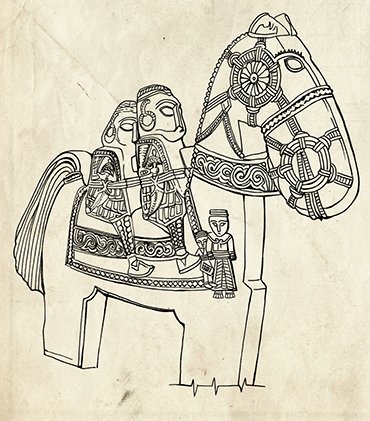 To sum up, the people depicted on the coins and stone statues look very similar, though this is our own opinion, and it is not that everyone has to agree with it. Surprisingly, modern people populating this high mountain area in Jammu look a lot like the ancient riders. The appearance of the men, women and children now living in the Ramban district suggests the way the people whose anonymous portraits are cast in stone might have looked in real life.
To sum up, the people depicted on the coins and stone statues look very similar, though this is our own opinion, and it is not that everyone has to agree with it. Surprisingly, modern people populating this high mountain area in Jammu look a lot like the ancient riders. The appearance of the men, women and children now living in the Ramban district suggests the way the people whose anonymous portraits are cast in stone might have looked in real life.
As for the carefully sculpted horse harness gear, the first thing that strikes the eye are large round cheek-pieces with bridle and reins strapped to them. Analogs of such cheek-pieces were discovered in the graves of the nomadic peoples populating the East-European and Central Asian steppes in the 5th c., supposedly united for a short time by the European Huns (Ambroz, 1981).
Other interesting and conspicuous details of the horse harness include a variety of strap decorations – horse brasses. The brasses of different size and made of different materials were used to embellish the horse harness from the ancient times to the late medieval period. At times, they were made of precious metals, which indicated the rider’s high status.
The absence of saddles and stirrups on the horse statues does not suggest that this ethnicity did not actually have them, the same as three of four riders on one horse does not mean that this was a common way to travel. Looking at these depictions, we should realize that these are mythical characters, though made after real-life prototypes. Every single object depicted on the statues existed in reality like did people and horses, who changed over to a new condition when they were carved in stone. The depictions are as overloaded with objects and detail, as the horses are overburdened with people…These characteristic features can be attributed to the memorial purpose of these monuments, which were meant to signify so muchThe horse harness of the stone horsemen is decorated with round brasses depicting a polypetalous flower (supposedly, the lotus). The same brasses decorated the harness gear of the horses carved on bone handicrafts from Bergam (Afghanistan, 1st c.) (Tyulaev, 1988). Sometimes, the brasses display a whirl pattern. Similar ornaments were found in the Sarmatian monuments of the 1st – early 2nd c.; also they occur in more ancient burial sites of the 3rd –2nd cc. BC (Mordvintseva, 2001). Their depictions can be found in Gandhara art. For example, on a relief from Charsadda whirl-pattern brasses decorate the harness of the rams pulling a cart with the youth Siddharth (Pugachenkova, 1982); on the stone sculptures in Palmyra brasses can be seen on the harness of a Parthian rider. Hence the brasses and other embellishments of the stone horsemen’s harness refer us to the harness of Eurasian nomads, who brought the equestrian culture to India.
On the way to eternity
The most original part of these monuments ruined by time and people are rock-hewn horses bearing two, three or even four riders. This extraordinary and unrealistic way of collective travel suggests that these are mythological characters: heroes, ancestors heading for the faraway land that every ethnicity fancies in its own way and where everyone complete their earthly existence. These must be monuments to perished warriors. There is something mesmerizing and alarming about this repetition of faces devoid of individuality and solemn postures of the petrified horsemen.
Both the horses and equestrians are depicted in much detail, with carefully sculpted fittings of harness, clothes, ornaments and arms. At the same time, we are looking at a stylized or primitive type of art: all the proportions of the human body are distorted, as well as the proportions of the arms and harness. The horses’ backs covered with tasseled carpets, similarly to oriental sofas, easily accommodate two, three or four people. The lookalike horsemen seem to be mythical, fictitious beings that have arrived from an unknown world. The details are redundant, which, for all one knows, may reflect the reality. Every horse deserves a separate description because though all the figurines we have seen and recorded (there are over 100 on just one site) look similar and indicate to a certain canon, each stone sculpture has its special features. The results of laser scanning and phototography will allow creating an electronic catalog describing each statue in detail.
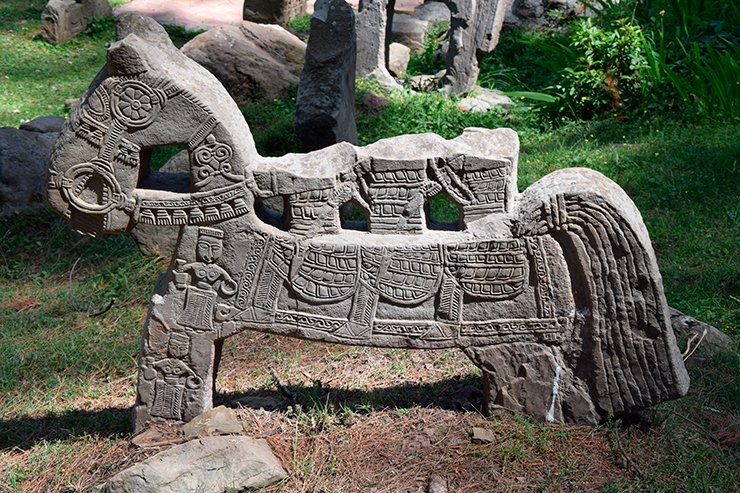
On both sides of the flat statues are finely and precisely carved details of horse harness, costume and arms. The horses’ legs, chest and croup bear carved depictions of women. The sculptures are of different size; many are over two meters high due to the long legs supporting them. Interestingly, we have observed that the legs were not dug deep into the ground, which may seem logical. On the contrary, these long legs rose above the surface, making the horses unrealistically tall.
Many of the statues were found fallen down, probably because of the earthquakes and landslides, which are frequent in this area. As for the heads missing from many riders, this is the result of barbarity of the subsequent epochs.
The horses’ faces are very expressive. In addition to the details of smart horse harness – big round cheek pieces, plates, nasels and richly tasseled straps – you can see big eyes, often with thick lashes; an open sharp-toothed mouth, often with a protruding tongue with a rolled tip. These long stuck-out tongues of the Himalayan stone horses is a trait indicating their magical nature. Apparently, these are not ordinary horses but supernatural beings connecting the worlds of the living and dead; they know the way to paradise and are taking their riders there…These horses are mythical creatures but the sculptors who created them were well familiar with their real prototypes, which is not true of some other depictions (like the elephant) looking improbable.
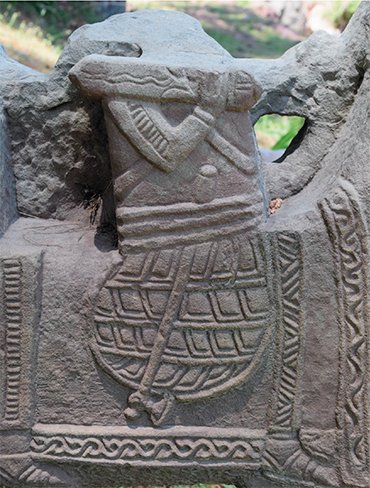 The riders’ costumes, like the rest, are stylized depictions of real clothes. The stone statues show an ideal warrior whose outfit combined armor and ornamented fabric. The clothes on the arms and legs are closely fitting. The riders are wearing tight-leg calf-length trousers and soft half-boots of varied styles and with various trimmings. Most warriors are dressed in armored jackets and skirts covering thighs. It should be noted that in Northern India scaled (and possibly lamellar) armor and its details appear as early as in the 1st c. BC, when Northern India became part of the Kushan state (Nosov, 2011). On their heads, the riders are wearing not combat helmets but round hats, flat on the top, with an undulated line design along the brim, depicting a stylized rambling branch. Some of the hats display curious details, like strings tied up on the top of the head. Interestingly, this type of headgear is still popular with the residents of the local settlements of Ramban district, along with the turban. A few of the stone horsemen are wearing a different kind of hats that look like short caps. Occasionally, from under them peep out very shortly cut straight hair.
The riders’ costumes, like the rest, are stylized depictions of real clothes. The stone statues show an ideal warrior whose outfit combined armor and ornamented fabric. The clothes on the arms and legs are closely fitting. The riders are wearing tight-leg calf-length trousers and soft half-boots of varied styles and with various trimmings. Most warriors are dressed in armored jackets and skirts covering thighs. It should be noted that in Northern India scaled (and possibly lamellar) armor and its details appear as early as in the 1st c. BC, when Northern India became part of the Kushan state (Nosov, 2011). On their heads, the riders are wearing not combat helmets but round hats, flat on the top, with an undulated line design along the brim, depicting a stylized rambling branch. Some of the hats display curious details, like strings tied up on the top of the head. Interestingly, this type of headgear is still popular with the residents of the local settlements of Ramban district, along with the turban. A few of the stone horsemen are wearing a different kind of hats that look like short caps. Occasionally, from under them peep out very shortly cut straight hair.
Some riders sitting next to the horse’s neck are holding a vessel in their left hand – a goblet shaped like a sand-glass, with its lower part is smaller than the upper. Some of the vessels are richly ornamented while the others are decorated more modestly. The solemnity with which the rider is holding the vessel in a raised hand suggests that the drink is an offering. The Rajputs are known to have greeted each other or their guests with a goblet of a foamy honey drink and, according to their beliefs, the Apsarases in paradise greeted the warriors who perished in a battle with similar goblets of wine (Uspenskaya, 2000).
A curved dagger, a straight sword
Before us are noble riders belonging to a caste of warriors, armed with richly adorned prestige weapons.
Bladed weapon testified to a high status of the warriors. This must be the reason why many of the stone riders carry both a dagger and a sword. Thus, with their right hand some of them are grasping the handle of a dagger with a curved blade in a richly decorated scabbard, stuck in a fabric belt. This is chilanum, a typical Indian dagger with characteristically shaped handle: its crossguards and pommel are disc-shaped or look like two curved stalks. The pommel invariably has a nut; the grip is thin, usually with a round thickening. Regrettably, archaeological findings of bladed arms of the early Middle Ages are extremely rare; therefore, the appearance of this kind of daggers cannot be dated accurately (Nosov, 2011).
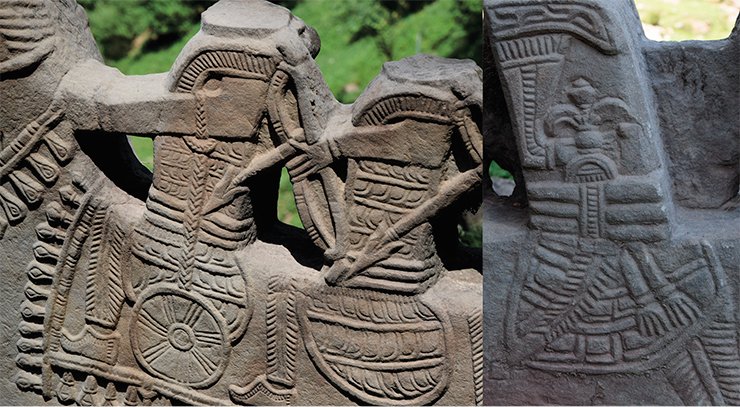
Another kind of bladed weapons depicted on the reliefs is a sword with a straight broad blade, uniform all along, which the riders carry horizontally on their right shoulder. Apparently, it is impossible to depict the size and shape of the swords realistically as they are too small. What we can see clearly is a large mushroom-shaped pommel with a nut. As it is known, if a warrior carried a sword without a scabbard, the blade had decorative plates attached to it. It could be these or some other marks considered fortunate like the Shiva sign that are depicted on the blades of the swords carried by the stone horsemen (ibid.).
By their left hand, all the stone riders hold a small segment-shaped bow with a feathered arrow pointing downwards. Socketed arrowheads with two barbs are outsized. You can see similar bows on Gupta reliefs – at the time they coexisted with the big bows of human scale. The two types of bows continued to be used later (ibid.).
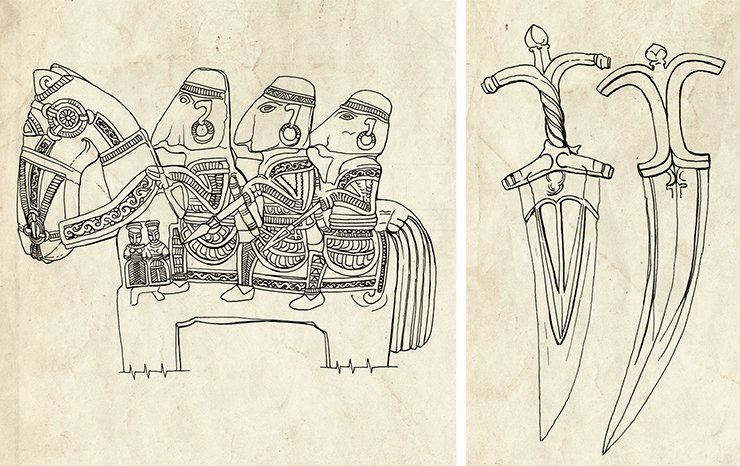
The nomads of Central Asia would always carry their scabbards hung on to the belt. In ancient and early medieval India though, the scabbards used to be hung on the back of the right shoulder, as we can see of the Sanchi reliefs as early as in the 1st c. BC. The Himalayan warriors carry their scabbards in exactly the same manner. The Assyrian and Median warriors carried their scabbards behind the back. In India, they began to carry scabbards on the right side following the Central Asian tradition only in the 13th c. (Nosov, 2011).
Just a few of the stone riders have battle axes stuck in belt instead of a dagger. Similar axes with an eye (a hole for the haft) were spread as early as in the end of the 1st c. BC, as illustrated by the findings in Taxila (Ilyin, 1958).
The round decorated shields depicted on the reliefs look inadequately small. Judging by the known pictorial sources, warriors, when off the field, hang their shields behind the back using a special strap or on to the belt on the left side (Nosov, 2011). The small shields of the Pir Panjal riders hang on a braided cord attached to the left forearm. We can see the same kind of shields in the depictions of Sanchi, Ajanta frescoes (5th – 7th cc.), Gupta reliefs and Palmyra reliefs in Syria (Schlumberger, 1985). Small shields were popular with riders in later times too: they are depicted on the Khajuraho statues of the 10th –12th cc. and on the relief showing Rajputs on the Chittor castle gate (15th c.) (Nosov, 2011). To sum up, we can conclude that the full set of weapons depicted on the Pir Panjal statues has a wide chronological framework in Indian culture. Whatever the depicted warriors were, they had been sufficiently “Indianized,” were able to use the exceptionally efficient Indian weapons and familiar with the ways to carry them.
Woman’s place
Sometimes you can see an equestrienne next to the men and always the last in a row. The women are distinguished by long, past shoulder hair, a diadem, temple pendants along the cheeks and absence of weapons. Nestling behind one equestrienne is a baby. As for the rest, the women look like the men, and their costumes are similar to armor.
We can find the analogs of diadems and temple pendants worn by the stone horsewomen in the adornments discovered in the tombs of the nomads of the East European and Central Asian steppes of the 5th c. (Ambroz, 1981). The set of decorations of these women nomads differs from the men’s only by a diadem and temple pendants, similarly to the Himalayan equestriennes.
As a rule, the women are depicted on the surface of the horse’s croup, by ones, in pairs or in groups. These are small figurines in long skirts ornamented with a geometrical pattern, tied around the waist with a broad belt made of cloth. Sometimes you can see bare feet peeping out from under the skirts. The upper part of the body seems naked, as you can see breasts: probably, the women were wearing blouses made of transparent fabric. The women have necklaces and a high headgear covering the hair.
As we can see, this women’s costume is nowhere near the traditional Indian costume, which is a sari. It is known that long full skirts and blouses were worn, among others, by the Rajput women (Uspenskaya, 2000). Women played a large part in the Rajput society and, most importantly, their help to their husbands had a sacred meaning: the woman had the power to keep her husband among the living or prepone his death by wrongdoing. As a rule, the Rajput women voluntarily parted from this life following their husbands (ibid.). Possibly, the mandatory presence of female figurines on the horse statues confirms these ancient customs of the Rajputs and at the same time commemorates the dead women and children.
The female full faces have as long (bird-like) noses as the male. In one hand, the women are holding a lipped jug, and in the other, a ring-shaped object looking very much like a festive garland. Such garlands can be frequently seen in the hands of the dancers depicted on the precious tableware of Iranian grandees dating from the 5th –6th cc. (Lukonin, 1977). Another important function of these garlands in that they were a sign of victory used to crown heroes.
Sacred water
Surprisingly, stone horses with groups of equestrians and occasionally equestriennes are not the only sights of Pir Panjal. The extraordinary stone statues are placed next to a cascade of small basins descending along the mountain slopes. The basins must have been intended for ritual ablution, which links these monuments with Hinduist traditions. Many of the basins are turfed, overgrown with grass and bushes but remain a source of water for local residents.
These small artificial water reservoirs are walled with flagstones of gray shale rock. The flagstones are decorated with big rosettes in the form of open lotuses. Some of the rosettes look more like the Dharma wheel, a Buddhist symbol of learning and transfer of knowledge. Exactly the same depictions can be seen on one of the most ancient Buddhist stupas, Sanchi Stupa (1st c. BC).
The depictions of lotuses occurred in Hindu culture, which lent them to Buddhism. The lotus flower symbolizes spiritual ascension. The basin where the plant grows is a symbol of the world of the uninitiated, where people spend their time pandering to their passions. The leaves spreading out on the water surface signify the revival of consciousness and craving for transfiguration, and the bud opening in sunlight means enlightenment… This might have been what the riders sought when approaching these water pools. The Rajput poems describe a special rite of worshipping a horse before a battle. The rite was performed by the warrior himself, his mother or wife. Before the horses were adorned, they were led to a water reservoir for watering and washing (Uspenskaya, 2000).
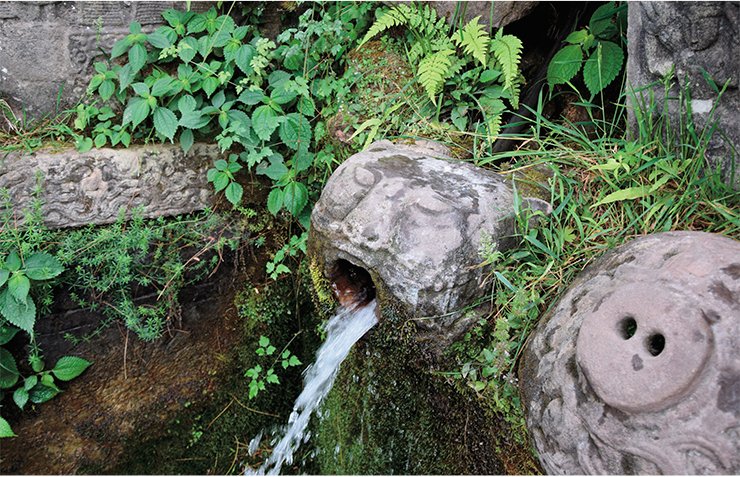
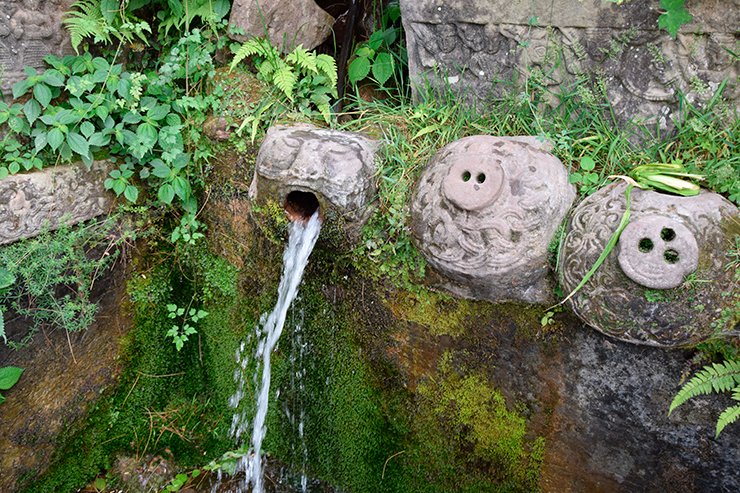
In addition to the statues, stepwells and plates found on the sites, there are some stone pieces of other architectural structures, with their main part buried deep in the ground. However, in order to determine to what particular structures these stone plinths with carving belong, exploratory digging is needed
The Pir Panjal basins were filled with the water of mountain brooks flowing in through small round holes in beautiful stone spouts styled after decorated vessels. Sometimes instead of a vessel there is a tiger’s head with an open mouth ejecting water.
Similar decoration of sources occurs in Hindu culture until the present day. In the 1960s, Sviatoslav Roerich wrote that in some places of the Kullu Valley at the foot of the Pir Panjal Range in Himachal Pradesh you can still see springs decorated as the heads of lions or makaras, mythical aquatic monsters, and next to the Bashist basin there was quite a large slab decorated with a floral design and depictions of gods. The artist also mentioned a big deserted pond faced with ashlar stone, which used to have some carved details, in Tava near Naggar. By the time the masonwork had mostly crumbled and was used in subsequent construction works (Roerich, 2011).
Much later, in the early 21st c., in another valley of the same state – the Pangi Valley, Chamba district – Indian archaeologists discovered numerous reservoirs having stone slabs with carvings depicting floral and geometric motifs, lotuses, and men and women drinking water. These structures resemble the ones found in Jammu. The researchers date the Hindu temples situated in these parts by 6th –17th cc., making a point though that many of them were built from the stones of more ancient constructions (Indian Archaeology 2001—02: a review, 2008).
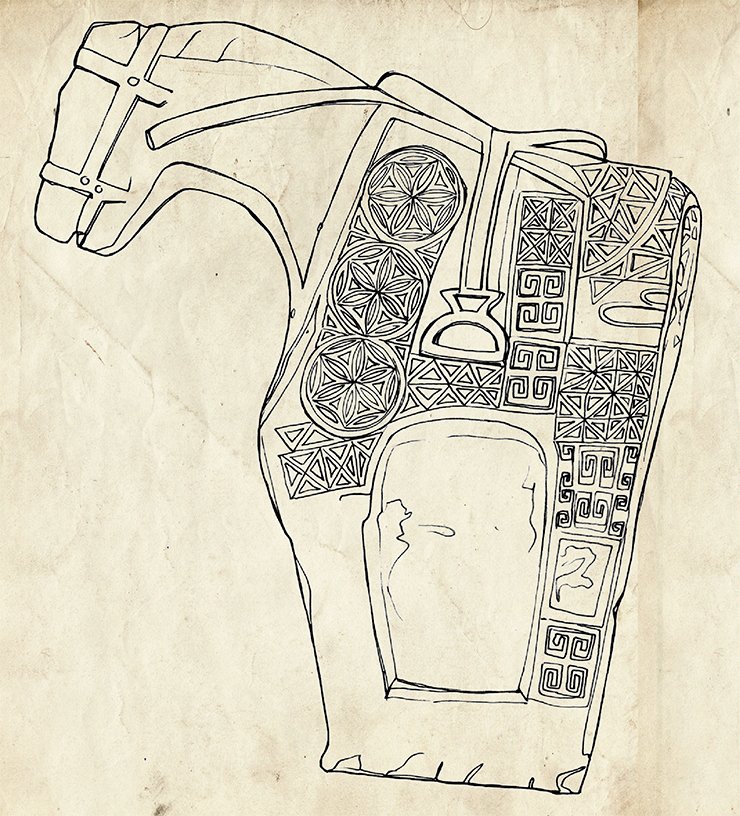
The stone statues of horses are common in northwestern Iran, East Turkey, Azerbaijan and Armenia. Since the medieval times they can be found on the tombs of warriors; depicted on many of them are different weapons like a bow with arrows, a quiver or a saber. Quite often you can see on the horses croups figurines of hunters with a bird in their hand. The stone horses are always shown fully harnessed, with stirrups and saddle but they never had riders, and this is their fundamental difference from the Himalayan statues. The origin of these stone sculptures is still being discussed (Pchelina, 1932; Efendiev, 1986). There is no consensus on their initial purpose, the time when they were made or the ethnicity of their sculptors. There is little doubt though that these stone horses are monuments to soldier riders like the ones in the Himalayas.
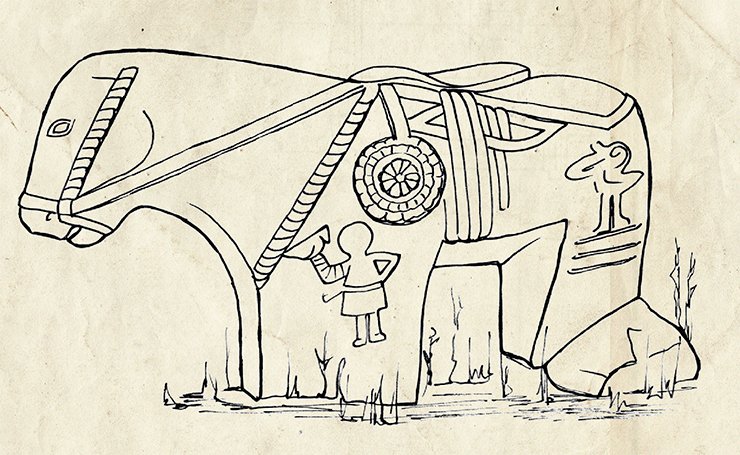
Even an initial investigation of the extraordinary statues from the Inner Himalayas suggests that these monuments belong to the tribes who arrived with the Hephthalites. As is known, there are three Hephthalite tribes that have managed to adjust to the North-Indian ecological and social environment: Rajputs, Gurjars and Jats. Descendants of the belligerent Rajputs are just as belligerent Dogra, the people still populating Jammu and the adjoining areas of Punjab, Himachal Pradesh and northeastern Pakistan. Possibly, these were the ancestors of Rajputs who left these remarkable statues. A well-known researcher of Rajput culture, Ye.N. Uspenskaya wrote, “They were apparently nomads, used to the steppes, horses, bows and arrows, and the martial way of life was as natural for them as, for example, for the Mongols” (Uspenskaya, 2000).
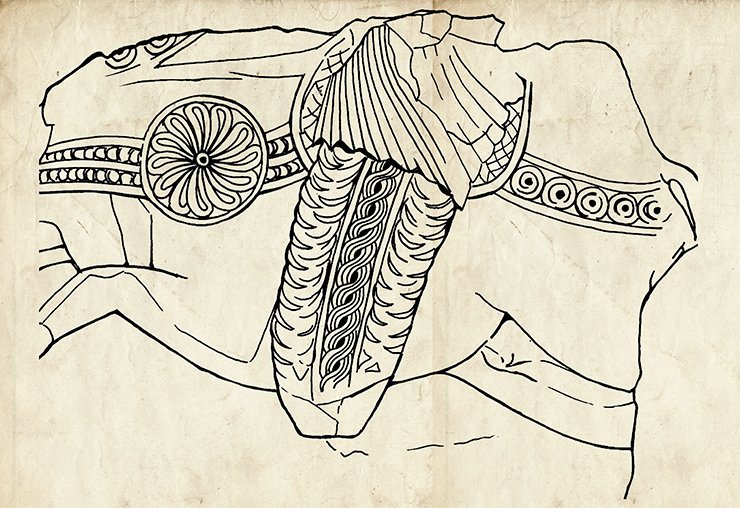
The object of our study refers to the earlier, possibly, “Hephthalite” history of these tribes on the territory of Northern India. The fully armed riders can be depictions of the heroes who perished in the last battle, in which no one was to survive. As a rule, such a battle came with a very ancient custom of the Rajputs, as of other bellicose tribes – jauhar, or mass self-immolation of the clan’s women. This might explain why the monuments were put not to individual warriors but to the warrior host including women and sometimes children. The special features of the religious symbols on the stone statues may also favor their Hephthalite origin since, according to written sources, this ethnicity practiced Buddhism, Hinduism (Shaivism), Zoroastrianism, Manichaeism and even Christianity, alongside some pagan cults (Isomatov, 2009). Hence, the ambiguity of the religious signs on the monuments under study, though they are more like Shaivism symbols than any other.
In western, central and northern India there are numerous memorial stones – monuments to heroes and sati, their widows who immolated themselves. They are especially many in Gujarat, Rajasthan and Himachal Pradesh. The origins of this tradition – setting up memorial stones – go up to the beliefs of the Vedic Aryans and orthodox Hindu practices, according to some scholars (Patil, 1982), or to early Buddhism and Central Asian influence, according to others (Chattopadnyaya, 1982). The Himalayan stone riders make part of this general phenomenon that has existed within the territory of India for a long time (nobody knows exactly how long). In each district, the memorial stones have their own specific features but there is nothing even slightly resembling the stone equestrians of the Himalayas – they are altogether unique.
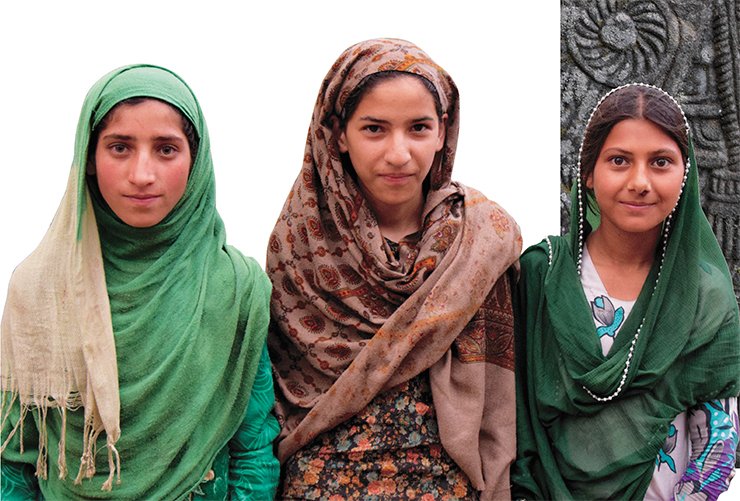
The most fascinating part of this story though is that the ethnicity that created these amazing statues did not disappear without leaving a trace: their descendants continue to live in this area not knowing that the stone statues standing in the way of their farming are in fact the memory of their ancestors and traces of their former glory.
References
Kurbanov А. D. Hephthalites: Historical Essays. St Petersburg: Yevropeiski dom, 2006. ISBN 5-8015-0203-3. [In Russian]
Ambroz А. K. East European and Central Asian steppes from the 5th to the first half of the 8th c. // Stepi Evrazii v epokhu srednevekovia. Moscow: Nauka, 1981, P. 10—23. [In Russian]
Roerich S. Art of the Kullu Valley // Indian painting. М.: Roerich International Center, 2011, 440 p. [In Russian]
Berensten V. Empire of the Great Mongols. Moscow: Astrel; АSТ, 2005, 160 p. [In Russian]
Indian Archaeology 2001–02: a review, New Dehi, 2008. 581 р.
Nosov K. S. Indian Traditional Weapons. Moscow: Eksmo, 2011, 384 с. [In Russian]
Trofimova Т. A. Depictions of the Hephthalite rulers on coins and the ancient Central Asian custom of artificial skull deformity // Istoriya, arkheologiya i etnografiya Srednei Azii. Moscow: Nauka, 1968, P. 179—189. [In Russian]
Pugachenkova G.A. The Art of Gandhara. Moscow: Iskusstvo, 1982, 196 p. [In Russian]
Uspenskaya Ye.N. Rajputs: Knights of Medieval India. St Petersburg: Eurazia, 2000, 384 p. [In Russian]
Tulayev S.I. Indian Art of 3rd millennium B.C. to 7th c. BC. Moscow: Iskusstvo, 1988, 344 p. [In Russian]
Efendiev Rasim Samed ogly (Rasim Efendi). Stone Plastic of Azerbaijan. Baku: Ishig, 1986. [In Russian]


